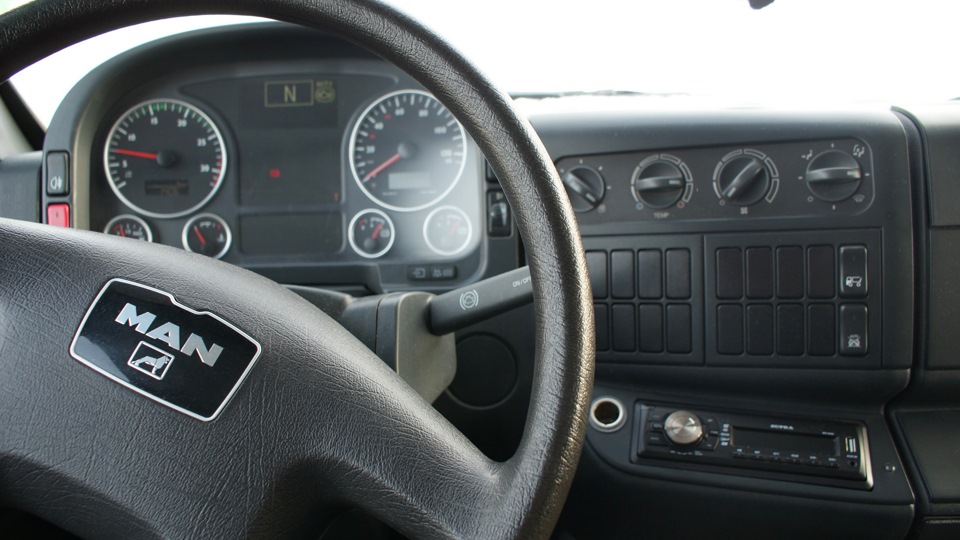Overview MAN TGL 12.180
Now let's return to the main topic of our review – the MAN medium-duty truck.
The history of the TGL model dates back to the 70s of the last century. At that time, MAN had a joint development with Volkswagen to produce cab over light commercial trucks. A Volkswagen LT cab was installed on the frame of the G90 medium-duty truck, and two MAN-VW emblems flaunted on the grille. Such trucks, although rare, can still be found on our roads.

Then, in 1994, the car underwent restyling and received a new, more spacious cabin and was produced under the L2000 index. The car lasted on the conveyor until 2005.
When it hit the market, the first TGL “Trucknology Generation Light” made a splash. In 2006 he deservedly received the Truck of the Year award. The car presented in this review is equipped with an engine that complies with environmental standards Euro 5. I will tell you how this is achieved a little later, but now, let's walk around the car. MAN TGL 12.180 with a net weight of 5730 kg became the lightest vehicle in the class of 12-ton trucks. The car is equipped with small, for its class tires, dimension 245/70 with a radius of 17.5 with a disc mount on six nuts.
The complete vehicle index is MAN TGL 12.180 4X2 BB, where the numbers indicate the permissible gross weight: 12 tons, and the engine characteristics: 180 l / s, chassis version and cab design. This instance is equipped with an isothermal van with refrigeration equipment. According to the service for the maintenance of refrigerators TakomaTruck.Repair (https://tacomatruck.repair/carrier-refrigeration-service), such a refrigeration unit is very reliable and easy to maintain. And the quality of this refrigeration unit is excellent. A huge cabin, and for a delivery truck, it cannot be called anything other than huge, has deep niches on the sides. All the driver's tools will be removed here.
The large cab required changes to the suspension of the delivery truck. Everything is grown-up here: powerful silent blocks in the front and air suspension in the rear. To lift the cab, a hydraulic pump and a power cylinder are used, the cab lock is equipped with a hydraulic drive.
Two 140 Ah batteries are hidden behind safety bars that severely restrict access. No matter how old-fashioned it may seem, the factor of quick access to the battery terminals is a priority for me to be on the safe side. By the way, the question is removed by installing the button on the power switch. Let's take a look into the cockpit.
The first impression when you get into the TGL cockpit is the feeling of free space, which will not be spoiled even by hard plastic. The designers managed to camouflage the age while preserving the inner comfort for the driver. The spacious interior is a feature common to all MAN vehicles.
The instrument cluster, in German, is simple and concise. Nothing superfluous, despite the fact that everything is functional, everything is in its place. A car from the category of those in which you sit down without long consultations “what is this button.” All the devices, all the toggle switches, exactly where they should be. The only thing I wasted time on was finding the steering column pedal. She is in a strange place for her, on the left under the driver's seat. In the next photo.
There are no complaints about the seat itself and the space of the working area. The driver's seat is equipped with the flagship long-range TGX.

MAN has never abused electric drives, and here, the hatch in the cab roof opens with an ordinary handle. By the way, you can safely reach the handle while in the driver's seat.
Devices that are ready to outlast the car itself with their performance. The mechanical drive of the sun visor, he was as happy as a child.
The sleeper for TGL trucks is the exception rather than the rule. A driver who gets an office with a sleeping bag can equate it with winning the lottery. Comfort at the highest level, the bed is 205 cm long and 75 cm wide.
Auxiliary control functions are concentrated on the driver's door. Power windows and mirrors control unit, door lock key. Powerful channels for heating side windows in the area of \ u200b \ u200bthe mirrors.
Here we are unlikely to find revolutionary solutions, everything is quite familiar. The necks of all the liquids to be poured, the oil dipstick, the silent blocks of the cab are brought out under the hood. Low-lying radiators, a common problem in all European distribution trucks, should be kept in mind by drivers.
Front suspension, surprised by the original solution. Perhaps, in Europe with its highways this is not surprising, but here! A single-leaf spring on a car with a gross weight of under 12 tons looks like something frivolous.
The rear suspension TGL is three-leaf, where there are two main and one rooted, there is also a pneumatic version. The drive axle beam is welded and equipped with a stabilizer bar. Permissible load on the rear axle 8400 kg.
The test TGL is powered by a four-cylinder D0834LFL70 diesel engine with 180 hp, which corresponds to 132 kW and a torque of 700 Nm. The motor meets the requirements of environmental safety standards Euro 5 without the use of urea. Common rail direct fuel injection system, EGR exhaust gas recirculation system to neutralize nitrogen oxides and MAN PM-KAT® proprietary particulate filter are used.